classic rock
Browse By
Sort By
- Popularity
- Price:Low to High
- Price:High to Low
- Name:A-Z
- Name:Z-A
Queen
Queen were an English rock band originally consisting of four members: vocalist Freddie Mercury, gui...
The Rolling Stones
The Rolling Stones are an English rock group that formed in London in 1962. First popular in Europe,...
U2
U2 is rock band from Ireland which formed in 1976 in Dublin, Ireland. Since the band’s formation, ...
Black Sabbath
Black Sabbath is an English heavy metal band that formed in 1968 in Birmingham, West Midlands, Engla...
Bruce Springsteen
Bruce Frederick Joseph Springsteen (born September 23, 1949 in Freehold, New Jersey, United States) ...
The Who
The Who are an English Rock Band formed in Shepherd's Bush, West London, United Kingdom, in 1964. Th...
Aerosmith
Aerosmith is a prominent American rock band. Three of its members, Steven Tyler, Joe Perry, and Tom ...
The Beach Boys
The Beach Boys are an iconic American rock band, frequently cited as one of the most influential and...
Bon Jovi
Bon Jovi is a hard rock band from Sayreville, New Jersey. Fronted by lead singer and namesake Jon Bo...

















